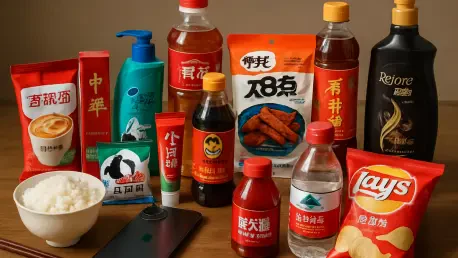In the sprawling landscape of China’s fast-moving consumer goods (FMCG) sector, a high-stakes rivalry between local companies and foreign multinationals is reshaping one of the world’s largest markets. From everyday essentials like toothpaste and shampoo to specialized products like diapers and skincare, this competition reflects not just economic trends but also deep cultural shifts within the nation. Once dominated by international giants who brought modern products and systems to a nascent industry, the arena now witnesses the remarkable ascent of domestic firms that have transformed from underdogs into formidable contenders. This clash is driven by evolving consumer preferences, technological innovations, and the sheer scale of a multi-billion-dollar market that serves over a billion people. As e-commerce redefines how goods are bought and sold, and as cultural pride fuels demand for locally resonant brands, the stakes have never been higher. This exploration delves into the historical roots of this battle, unpacks the strategies employed by both sides, and considers what the ongoing rivalry signals for the future of global consumer goods, offering a window into a dynamic and fiercely competitive industry.
Foundations of Dominance: Foreign Giants Shape the Market
The story of China’s FMCG sector begins in the 1980s, a time when the country’s economy was just opening to the world, and consumer goods were rudimentary at best. Basic items like shampoo were often sold from bulk containers in local shops, while modern conveniences such as disposable diapers were practically unheard of in most regions. Into this void stepped foreign multinationals like Procter & Gamble and Unilever, armed with globally recognized brands and deep expertise. These companies introduced products such as Head & Shoulders and Pampers, revolutionizing the market with quality and innovation that local firms could not match. Beyond just selling goods, they built the infrastructure for modern supply chains, crafted sophisticated advertising campaigns, and established production facilities that set industry standards. Their financial might and technological superiority allowed them to capture vast market shares swiftly, creating a landscape where foreign brands became synonymous with reliability and modernity in the eyes of Chinese consumers.
During this early period, local companies, many of which were state-owned enterprises, found themselves at a significant disadvantage. Hampered by inefficiency and a lack of know-how in critical areas like product development and marketing, they struggled to compete on quality or scale. While some domestic brands existed, their reach and impact were limited, often confined to niche or regional markets with little influence beyond their immediate areas. The disparity was stark, as foreign firms not only filled a product gap but also educated the market on modern consumption habits. This era of dominance laid a foundation where international players dictated trends and consumer expectations, setting a high bar for any local firm aspiring to challenge their supremacy. Yet, beneath this foreign-led market, the seeds of change were quietly being sown as economic reforms and exposure to global practices began to inspire a new generation of Chinese entrepreneurs.
Shifting Momentum: Domestic Brands Begin Their Ascent
By the dawn of the 2000s, China’s economic boom had started to alter the FMCG landscape, creating fertile ground for local companies to emerge as serious players. Rapid urbanization and rising consumer wealth spurred demand for premium goods, opening opportunities for domestic brands to address specific cultural and personal preferences that foreign products often overlooked. Pioneering firms like Shanghai Jahwa and Hengan International began to gain traction by offering products tailored to Chinese tastes, whether through unique formulations or branding that resonated with local identity. This period saw a marked shift as these companies focused on niche markets and regional strengths, allowing them to build a foothold without immediately confronting the nationwide dominance of international giants. The growing affluence of the middle class became a catalyst, enabling local brands to experiment with higher-quality offerings and slowly chip away at the perception that foreign equated to superior.
A critical factor in this transformation was the knowledge transfer that occurred during these years. Many Chinese entrepreneurs and professionals gained invaluable experience working for foreign multinationals, learning the intricacies of modern operations, marketing strategies, and product innovation. Armed with this expertise, they returned to domestic firms or started their own ventures, applying global best practices to local contexts. This infusion of talent and insight helped modernize operations at companies that had once lagged far behind. Additionally, the sheer diversity of China’s regional markets meant that smaller firms could thrive by focusing on specific areas, avoiding the need for immediate national scale. This strategic localization marked the beginning of a broader challenge to foreign dominance, particularly in categories like skincare and personal hygiene, where understanding consumer nuances proved to be a significant advantage.
Digital Disruption: E-Commerce Redefines the Game
The advent of e-commerce in China has been nothing short of revolutionary for the FMCG sector, fundamentally altering how products reach consumers and leveling the playing field for local brands. Platforms like Tmall and JD.com became powerful channels, allowing companies to bypass the costly infrastructure of traditional retail and connect directly with buyers across the nation. Domestic firms quickly adapted to this digital wave, leveraging tools like livestreaming and influencer-driven marketing to build brand awareness and drive sales at a fraction of the cost of conventional advertising. A standout example is Perfect Diary, a cosmetics brand that skyrocketed to prominence in just a few years through savvy online strategies, demonstrating how digital agility can propel a company to the forefront of a competitive market. This shift enabled local players to challenge the entrenched positions of foreign giants who had long relied on physical retail dominance.
Equally significant was the way e-commerce opened up previously untapped markets, particularly in lower-tier cities and rural areas. Foreign multinationals had historically focused their efforts on urban centers, often neglecting the vast potential of less developed regions due to logistical challenges and lower profit margins. Local brands, however, recognized the opportunity and used digital platforms to reach these consumers, tailoring their offerings to match local needs and budgets. By recent estimates, online sales account for a substantial portion of FMCG transactions in China, with the trend only accelerating as internet penetration deepens. This digital transformation has not only reduced barriers related to distribution but also empowered smaller domestic players with the ability to scale rapidly, creating a more competitive environment where adaptability often trumps sheer size or historical market presence.
Cultural Resonance: Localization as a Competitive Edge
One of the most potent weapons in the arsenal of Chinese FMCG companies has been their ability to weave cultural relevance into their products, forging a deep connection with consumers. Brands like Yunnan Baiyao in oral care and Herborist in skincare have successfully incorporated elements of Traditional Chinese Medicine, appealing to a population that values heritage and natural remedies. This approach not only differentiates their offerings from foreign alternatives but also fosters trust and loyalty among buyers who take pride in their national identity. By addressing specific local needs—such as formulations for sensitive skin or gum health—these companies have managed to carve out distinct market segments, often outmaneuvering international competitors who may prioritize global standardization over regional customization. The result is a growing preference for domestic products that feel both familiar and innovative.
In contrast, foreign firms have sometimes struggled to adapt swiftly to these cultural nuances, with products occasionally missing the mark in terms of relevance or appeal. While they possess global brand recognition, their slower response to evolving tastes has allowed local brands to gain ground, especially in categories where personal connection matters most. Domestic companies have also invested heavily in research to back their cultural claims with scientific credibility, overcoming past concerns about quality and safety that once plagued the industry. This blend of tradition and modernity has proven to be a winning formula, enabling Chinese brands to build robust consumer bases that are less swayed by the allure of international names. As cultural pride continues to influence purchasing decisions, localization remains a critical strategy in sustaining competitive advantage within this dynamic market.
Contemporary Landscape: A Divided Market of Strengths
Today, the FMCG sector in China presents a complex tableau where neither local nor foreign players can claim absolute dominance across all categories. Domestic brands have surged ahead in areas like toothpaste and feminine hygiene, commanding significant market shares through a combination of tailored products and aggressive digital outreach. Companies such as Yunnan Baiyao have become household names, benefiting from a deep understanding of consumer preferences and a focus on culturally resonant solutions. Their success in these segments reflects a broader trend of growing confidence in local quality, bolstered by investments in research and development that rival international standards. This shift has forced foreign competitors to reassess their strategies, as the once-assumed superiority of their brands no longer guarantees market leadership in every domain.
Conversely, foreign giants maintain strongholds in categories such as disposable diapers and haircare, where their global experience and established brand equity continue to hold sway. Names like Pampers and Head & Shoulders benefit from decades of trust and a reputation for consistent quality, appealing to consumers who prioritize reliability over local appeal in certain product lines. Despite the inroads made by domestic firms, these international players leverage their extensive resources and worldwide innovation pipelines to retain significant influence, particularly in premium and specialized markets. The split nature of this competitive landscape underscores a nuanced balance, where each side capitalizes on distinct strengths—local firms on agility and cultural alignment, and foreign companies on scale and historical presence. This duality ensures that the battle for consumer loyalty remains intensely contested across diverse product categories.
Future Horizons: Navigating an Evolving Rivalry
Looking ahead, the rivalry between local and foreign FMCG companies in China promises to intensify as both sides adapt to an ever-changing market environment. Domestic brands have already demonstrated remarkable growth, fueled by economic expansion, digital innovation, and a supportive business climate that encourages local entrepreneurship. Their ability to pivot quickly, whether by launching premium lines or expanding into international markets, positions them as serious global contenders in the coming years. At the same time, the focus on research and cultural integration continues to strengthen their domestic appeal, suggesting that their influence will only deepen as consumer preferences evolve. Industry observers anticipate that these firms will increasingly set trends rather than follow them, potentially reshaping global standards in consumer goods.
Foreign multinationals, while no longer the unchallenged leaders they once were, are far from conceding defeat. Many are actively refining their approaches, investing in localized product development and digital strategies to reclaim lost ground. Their global networks and financial resources provide a buffer to weather competitive pressures, allowing for strategic experimentation in a market that remains crucial to their worldwide operations. The interplay of these forces points to a future of dynamic competition, where success hinges on the ability to anticipate consumer shifts and harness technological advancements. As this rivalry unfolds, it offers valuable lessons for other industries and markets, highlighting the importance of adaptability, cultural insight, and innovation in sustaining relevance amidst rapid change. The path forward will likely involve collaboration as much as competition, with partnerships and knowledge-sharing potentially shaping the next chapter of this ongoing saga.









